Tafelwein and Qualitätswein are classifications of German wine that reflect their quality level and geographical origin. Tafelwein, or table wine, is considered a basic level wine, made from grapes harvested from a wide range of German vineyards. In contrast, Qualitätswein, which encompasses Kabinett, Spätlese, Auslese, Beerenauslese, among other designations, is made from grapes grown in specific, high-quality viticultural regions and is subject to stringent regulations.
Kabinett wines are made from fully-ripened grapes and are known for their light, fresh flavors. These wines are typically low in alcohol and pair well with a variety of food. Spätlese wines are made from grapes harvested later than Kabinett grapes, resulting in a wine with more intense flavors and a bit more sweetness. Auslese wines are produced from carefully-selected, very ripe grapes, creating a rich and elegant taste profile.
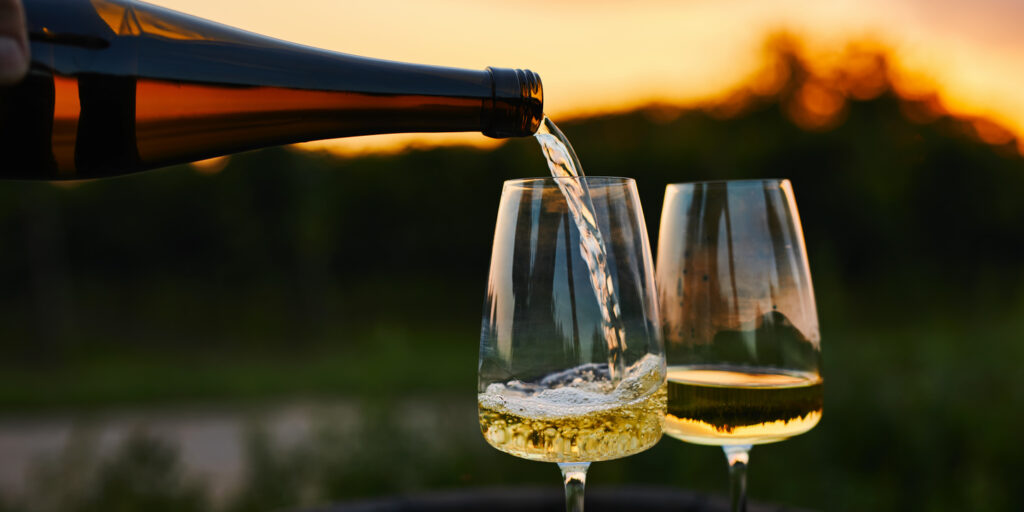
Beerenauslese wines are unique due to the way they are made from individually-picked, overripe grapes affected by noble rot, which concentrates the sugars and flavors. This results in a highly sweet, luxurious dessert wine. The various classifications and styles of German wines allow wine enthusiasts to explore a diverse range of flavors, aromas, and complexity, all while celebrating the tradition and craftsmanship of German Wine or Deutscher Wein.
German Wine Classification
German wine classification is based on the Qualitätsstufen (quality levels) system, which categorizes wines according to their quality, origin, and ripeness of the grapes. This system aims to provide clear information to consumers about the wine they are purchasing.
Tafelwein is the most basic level of German wine classification. It comprises wines made from grapes harvested from various vineyards across the country. Tafelwein is considered an everyday wine, typically consumed during casual meals and social gatherings.
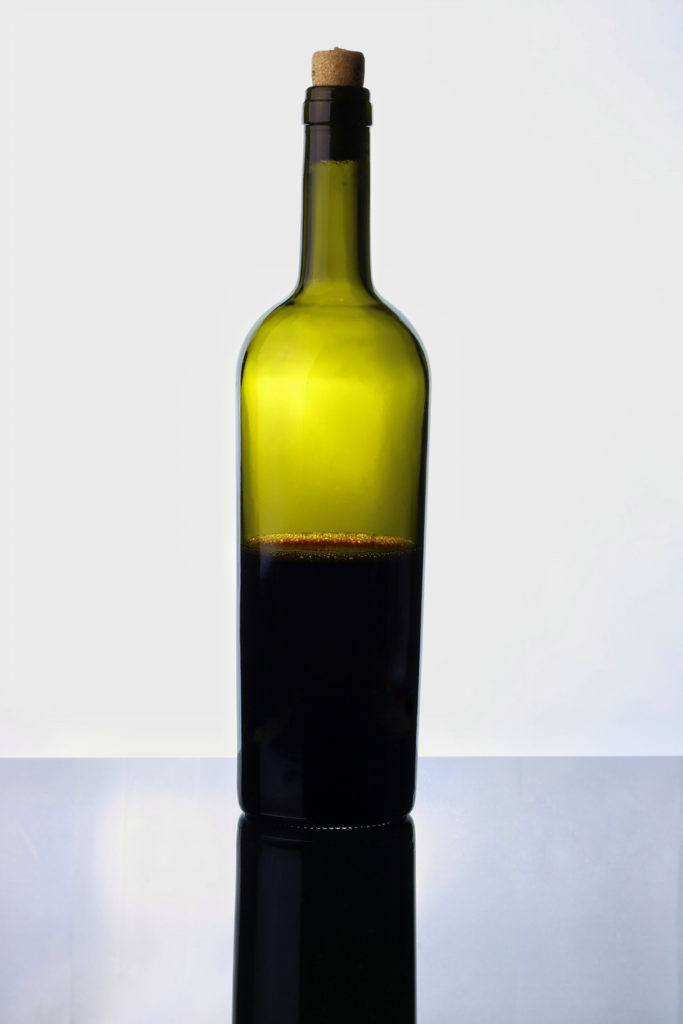
Qualitätswein is a step above Tafelwein and represents wines with a higher quality. These wines must come from one of the 13 designated wine-growing regions in Germany and adhere to strict quality standards. Winemakers must also submit their Qualitätswein to a taste test for official approval.
The remaining classifications fall under the umbrella of Prädikatswein, which are the highest quality wines in Germany. Prädikatswein is classified into five subcategories based on the level of sugar in the grapes at harvest time:
Kabinett
These wines are made from fully ripened grapes, resulting in a light and delicate flavor profile. Kabinett wines typically have lower alcohol content and can be enjoyed as a refreshing aperitif or paired with lighter dishes.

Spätlese
Literally translating to “late harvest,” Spätlese wines are made from grapes harvested after the main harvest season. This extra time on the vine allows the grapes to develop higher sugar levels, creating a more complex and full-bodied wine. Spätlese wines are versatile and can be enjoyed both young and aged.
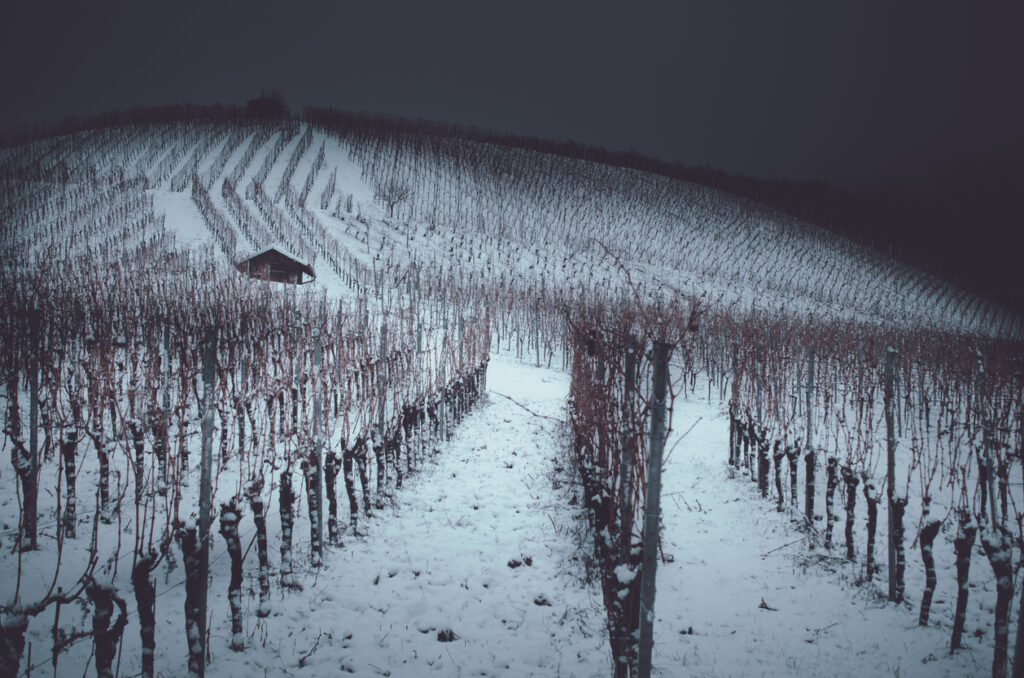
Auslese
This classification includes wines made from hand-selected, very ripe grape bunches. Auslese wines are generally more intense in flavor and concentration than Spätlese. They can be sweet or dry and are excellent choices for sipping on their own or alongside rich, flavorful dishes.
Beerenauslese
Wines in this category are made from overripe grapes that have been individually picked, often affected by noble rot (botrytis). This results in a highly concentrated, rich, and sweet wine, usually reserved for special occasions and dessert pairings.
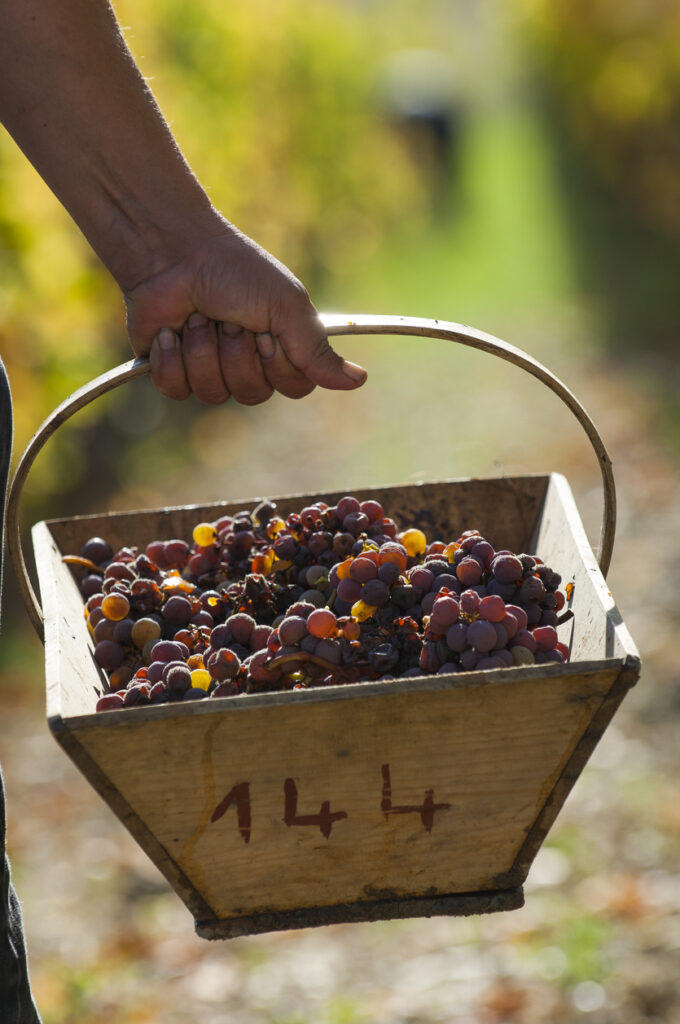
When choosing a German wine, consider its quality classification, which offers insight into the wine’s characteristics and flavors. By understanding the different qualitätsstufen, one can make informed decisions and appreciate the diverse offerings of Germany’s wine landscape.
Tafelwein
Tafelwein, or table wine, is a basic classification of wine in Germany. It is light and often served with meals. Typically, Tafelwein is produced from various grape varieties, including Riesling, and is considered an everyday wine.
Tafelwein, as a classification, does not hold any geographical indication, making it a “Wein ohne Herkunftsangabe” (wine without origin). However, there are certain regulations that the wine must adhere to, such as a minimum alcohol level and a prohibition against adding sugar or artificial flavors.
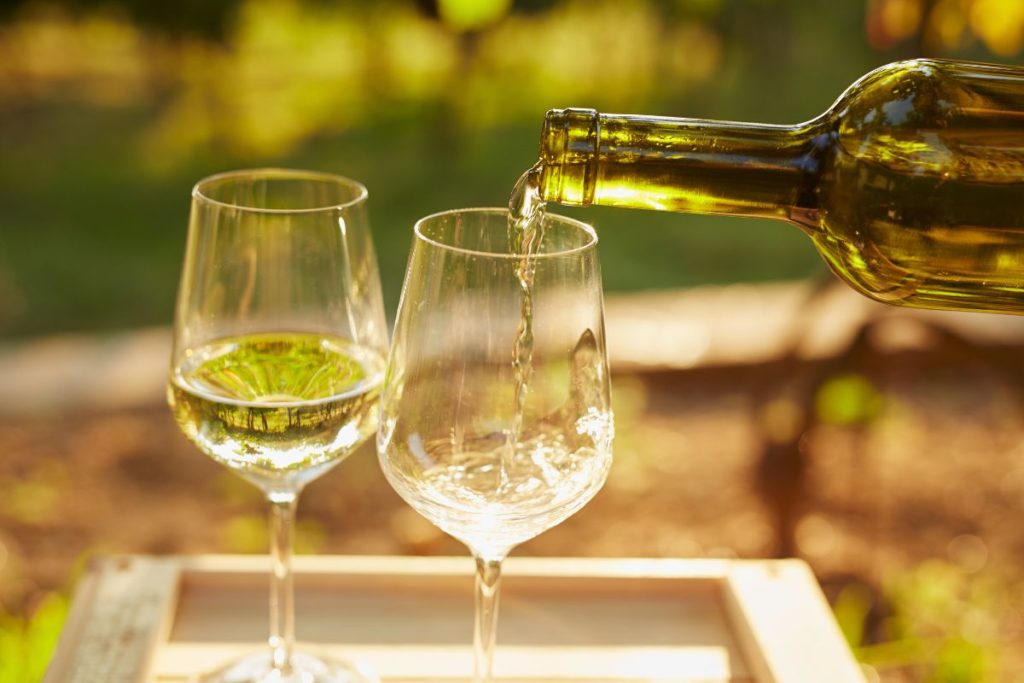
Landwein
A subcategory of Tafelwein is Landwein. This classification offers a slightly higher quality level than its counterpart. Landwein must come from one of the designated areas in Germany, ensuring its quality and origin. While primarily produced from Riesling grapes, other varieties can also be utilized for Landwein production.
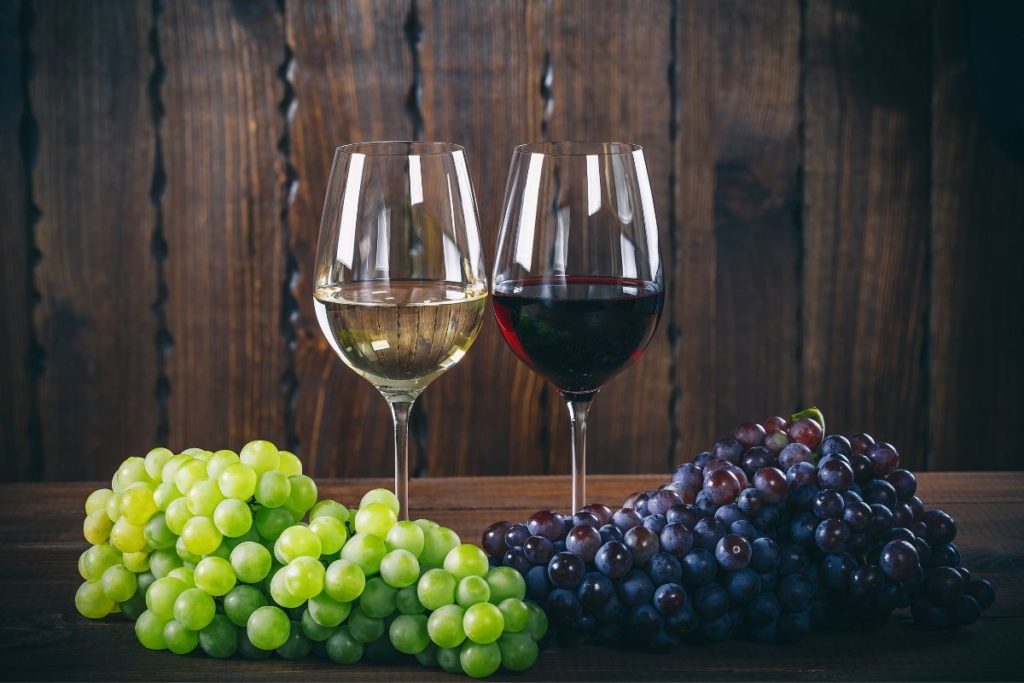
To better understand the differences of these classifications, consider the following:
- Tafelwein:
- Alcohol Level: Minimum required
- Geographical Indication: None (Wein ohne Herkunftsangabe)
- Grape Varieties: Various, including Riesling
- Quality: Basic, everyday wine
- Landwein:
- Alcohol Level: Slightly higher than Tafelwein
- Geographical Indication: Designated areas in Germany
- Grape Varieties: Primarily Riesling and others
- Quality: Slightly higher quality compared to Tafelwein
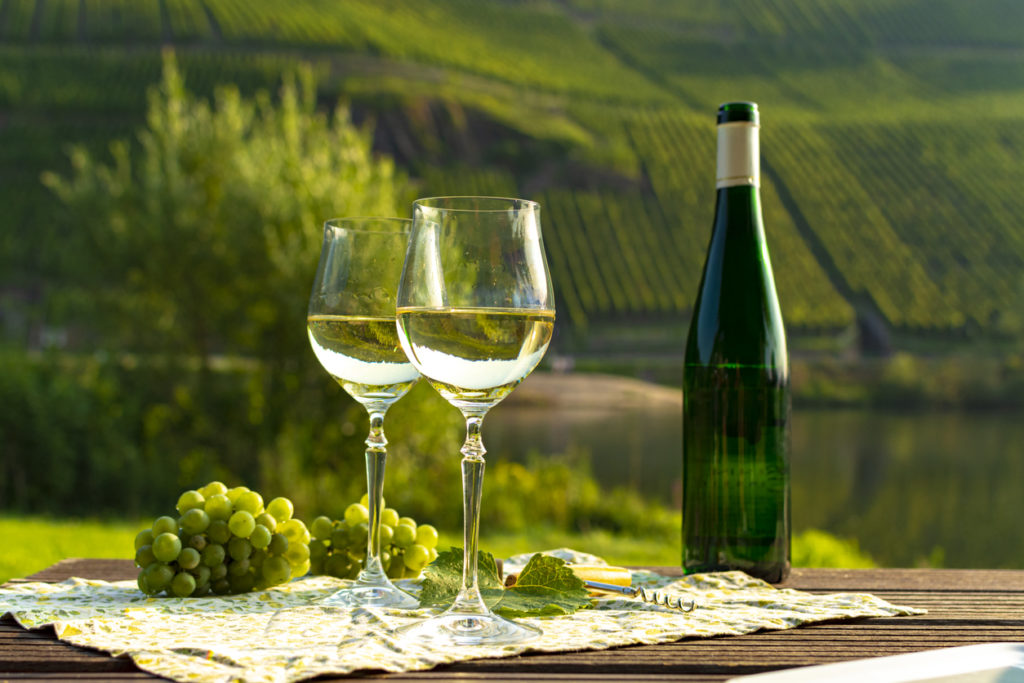
In conclusion, Tafelwein represents a basic and affordable option for wine enthusiasts, while Landwein offers a slightly higher quality level with a specific geographical indication. Both wines can be enjoyed during meals or casual gatherings, showcasing the diversity of German wine production.
Qualitätswein
Qualitätswein is a classification of quality wine in Germany, recognized by the designation “Qualitätswein bestimmter Anbaugebiete” (QbA). It represents a step up from the basic Tafelwein classification and is subject to more stringent regulations. Qualitätswein can be produced from a range of grape varieties and styles, offering consumers a diverse selection of wines to enjoy.
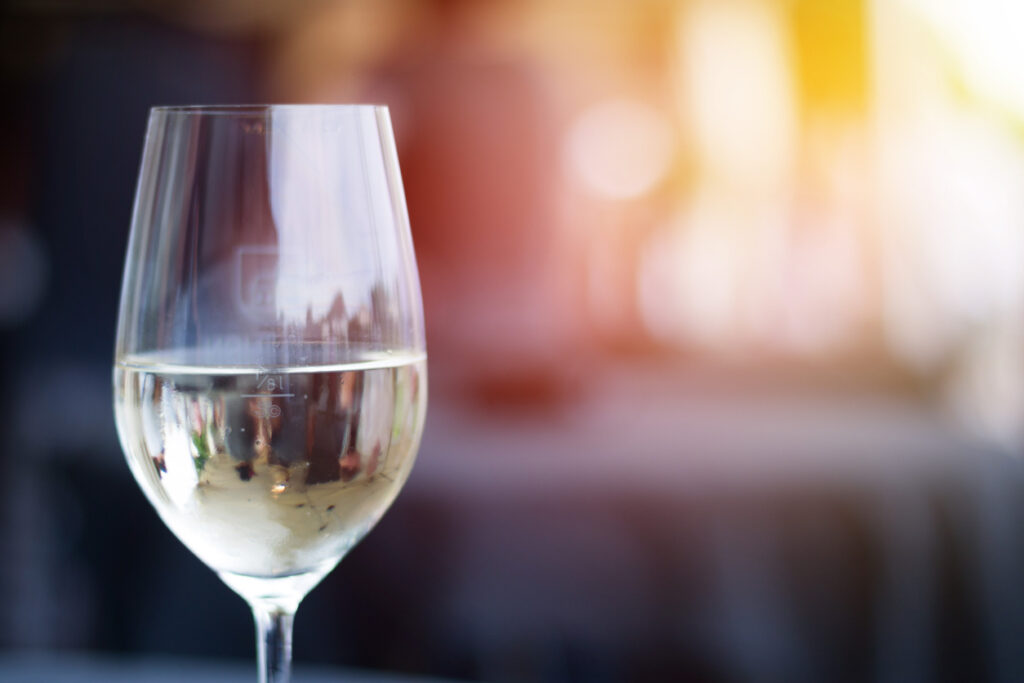
To be classified as Qualitätswein, the wine must meet specific quality levels established by the German Wine Law (Weinmarktordnung). This includes the use of approved grape varieties, adherence to viniculture practices, and meeting minimum required natural sugar levels at harvest.
Qualitätswein Mit Prädikat
Within the Qualitätswein category, there is a sub-classification known as “Qualitätswein mit Prädikat” (QmP) or “Prädikatswein”. This esteemed category of German wines denotes superior quality and includes the well-known classifications of Kabinett, Spätlese, Auslese, Beerenauslese, Trockenbeerenauslese, and Eiswein.
Prädikatswein levels are determined by the ripeness of the grapes, with higher sugar concentrations typically indicating a higher-quality wine. Trocken (dry) wines are also part of the Qualitätswein classification, and their natural sugar levels must fall within approved limits.
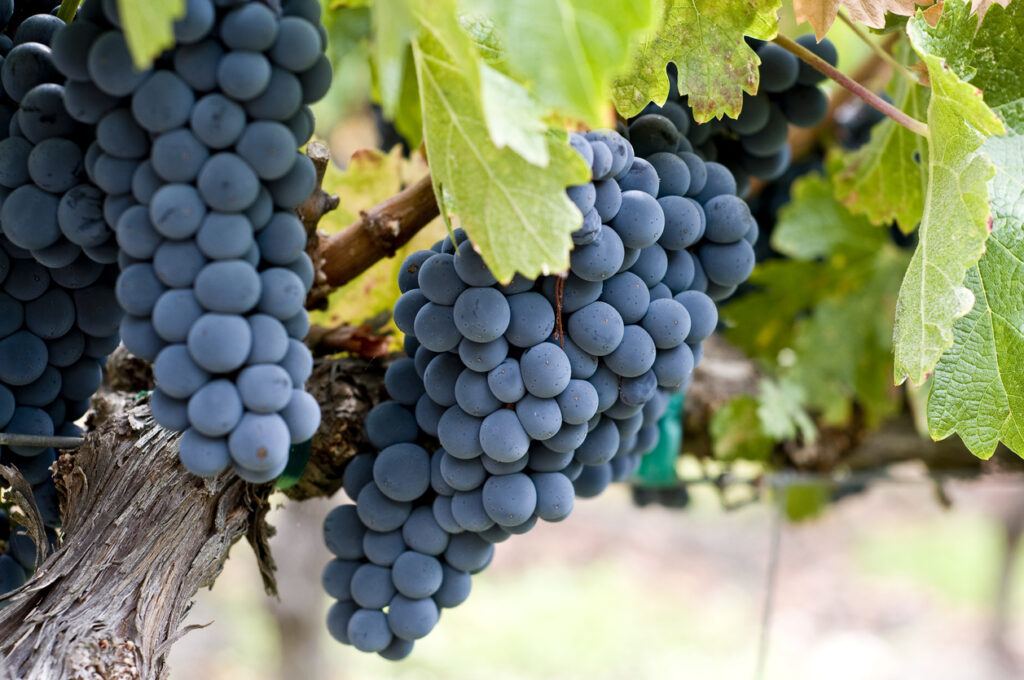
In summary, Qualitätswein represents an important classification within the German wine market, reflecting higher levels of quality and craftsmanship as compared to basic Tafelwein. The even more selective Qualitätswein mit Prädikat category further elevates the status of exceptional German wines, highlighting the country’s rich viticultural heritage.
Kabinett
Kabinett wines are a classification in the German wine hierarchy, positioned between Qualitätswein and Spätlese. These wines are typically made from fully ripened grapes, resulting in a delicate balance of acidity and natural sweetness. Riesling is one of the most common grape varieties used for Kabinett wines, showcasing the characteristics of the terroir and climate.

Alcohol Content
The alcohol content of Kabinett wines is often lower than that of Auslese or Spätlese wines, usually ranging between 7-10%. This lower alcohol level helps maintain the freshness and vibrancy while allowing the unique flavors of the grape to shine through. The focus on purity and balance makes these wines highly versatile, enjoyable both as standalone sippers and ideal partners for various dishes.
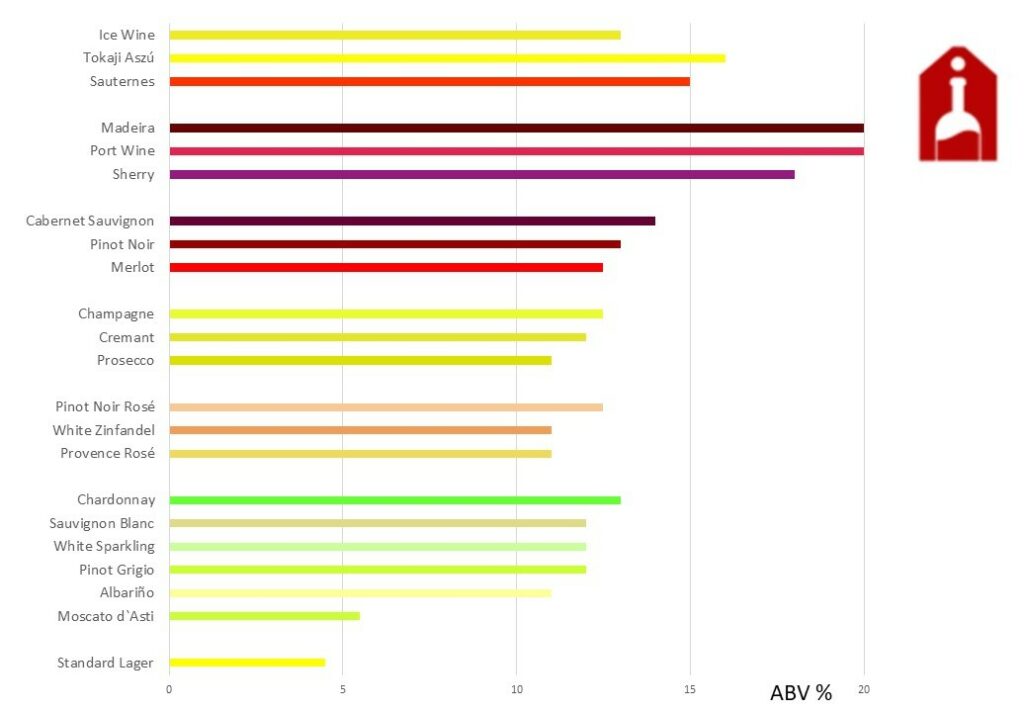
Style and Complexity
Kabinett wines offer an excellent introduction to the German wine world, especially for those who are looking to explore the diverse styles and complexity without the heaviness of higher-tier designations like Auslese. These wines are known for their crisp acidity, fruity flavors, and an underlying minerality that provides a sense of place and distinctiveness.

In summary, Kabinett wines provide a gateway to the intricate nuances of German wine, championing Riesling’s varietal characteristics and reflecting the regions’ diverse terroirs and climates. With their lower alcohol content and balanced profiles, these wines offer both accessibility and versatility for wine drinkers seeking a flavorful and nuanced experience.
Spätlese
Spätlese, which translates to “late harvest,” is a German wine classification level under the Prädikatswein quality category. It indicates that the grapes have been harvested later than usual, allowing for a higher sugar concentration in the wine. These wines typically have a more complex flavor profile and a higher potential for aging.
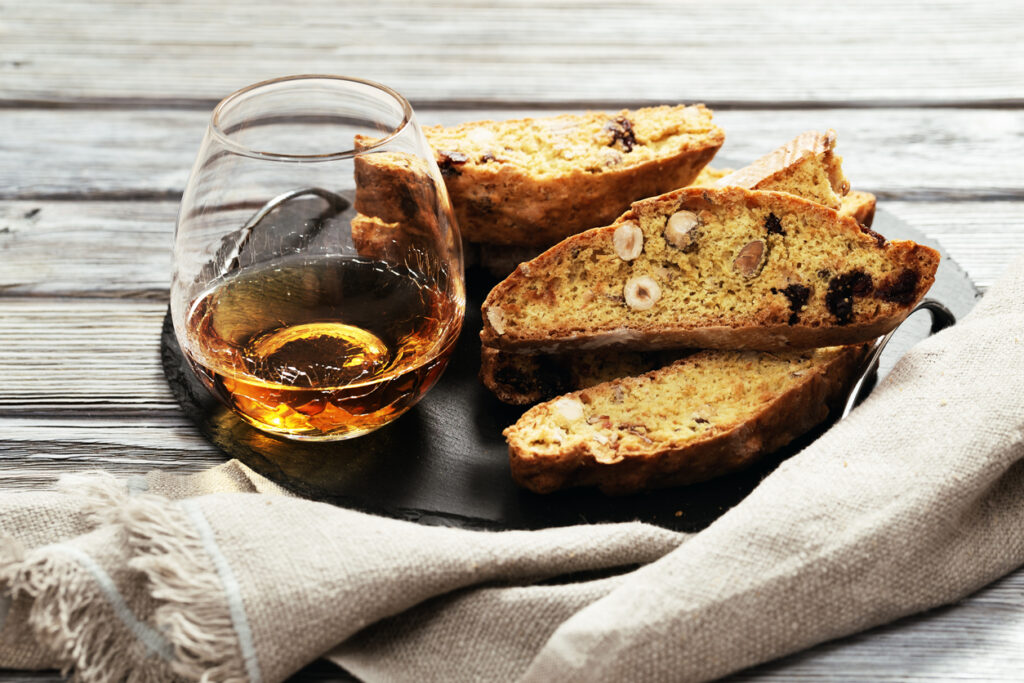
Sugar Content
Although Spätlese wines generally have a higher sugar content, they can be produced as either dry or sweet wines. Notably, in the German wine region of Mosel, Riesling Spätlesen often have a marked balance of sweetness and acidity, demonstrating the versatility of the grape variety and the winemaking techniques employed.
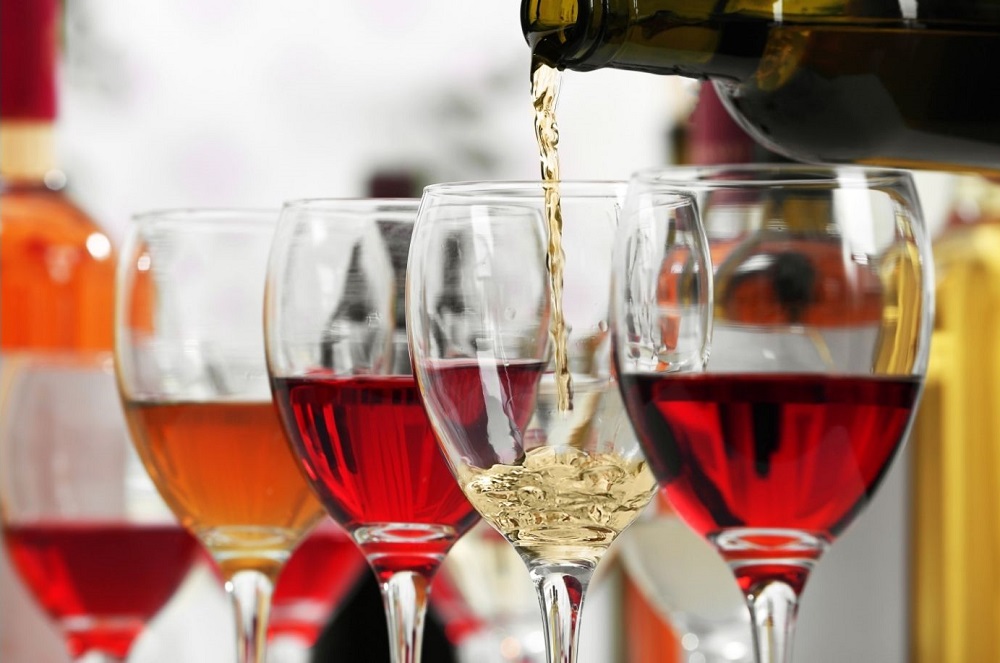
In comparison to other Prädikatswein classifications like Kabinett and Auslese, Spätlese wines tend to have a more pronounced fruit character and increased body. This is primarily due to the extended ripening period, which offers an opportunity for the grapes to develop richer flavors and greater complexity.
Popularity
Spätlese wines are popular amongst wine enthusiasts for their distinct qualities and ability to pair well with a variety of dishes. In particular, they can complement rich and spicy foods, such as Thai or Indian cuisine, as well as fruit-based desserts or aged cheeses.
In summary, Spätlese wines are a testament to the art of winemaking and the unique characteristics that late-harvest grapes offer. With their distinct flavor profiles and versatile pairing options, they continue to be a sought-after classification among both casual consumers and connoisseurs alike.

Auslese
Auslese, which translates to “select harvest” in English, is a high-quality German wine classification, denoting wines made from carefully hand-selected, very ripe grapes. Focusing on quality and careful selection, Auslese wines are typically sweet but can also be produced as dry or off-dry styles. These wines exhibit bright fruit flavors with higher levels of residual sugar, making them more luscious and intense than their counterparts such as Kabinett and Spätlese.
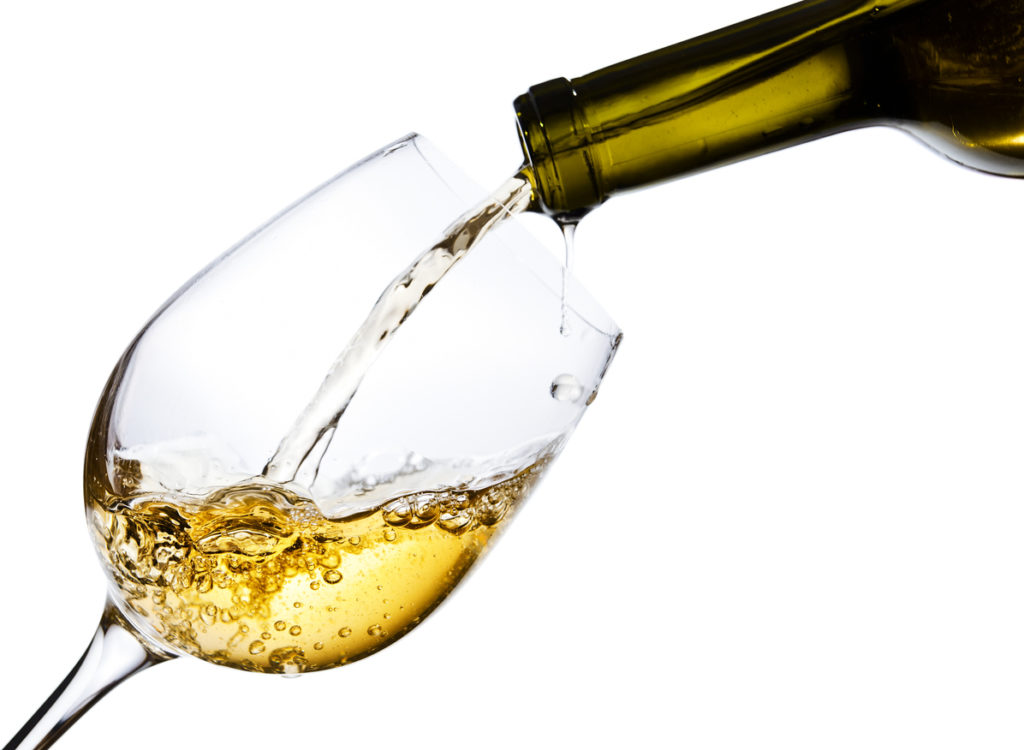
Criteria for Auslese Wines
Although affected by noble rot (Botrytis cinerea) in some cases, Auslese wines primarily consist of grapes that aren’t yet affected by the fungus. However, while noble rot is not a requirement for Auslese wines, it does play a crucial role in elevating the quality of certain varieties. The beneficial fungus helps concentrate the sugars and flavors in the grapes, resulting in wines with a richer taste and higher levels of acidity.
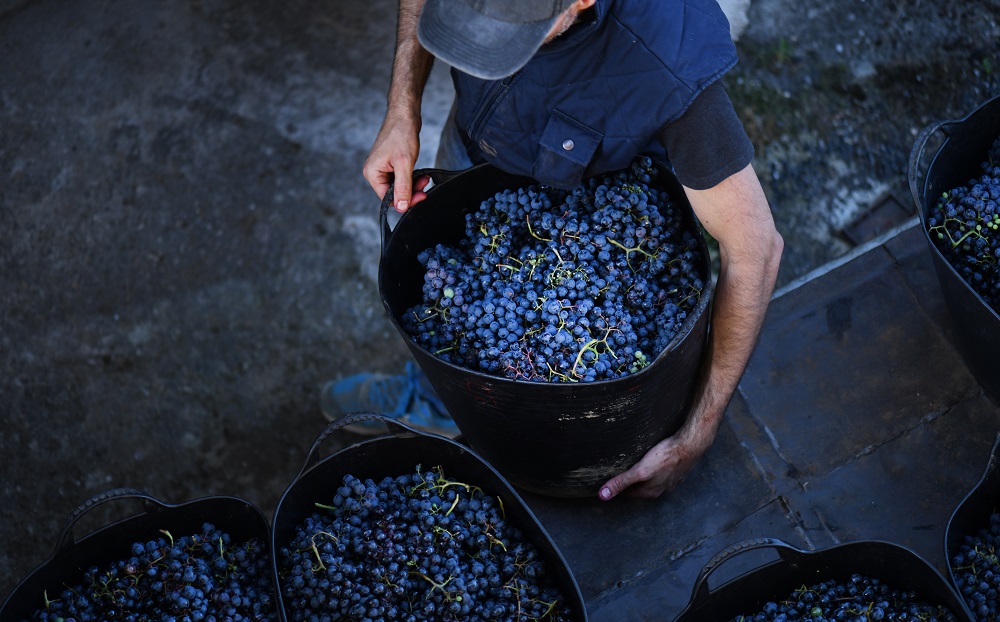
Compared to other wine classifications, Auslese is often considered a level below Beerenauslese. While both of these classifications value ripe and carefully selected grapes, Beerenauslese wines are made exclusively from grapes affected by noble rot. This results in an even more concentrated flavor, making Beerenauslese wines intensely sweet and highly sought after by wine collectors.
Grapes used for Auslese Wines
Auslese wines are predominantly produced from Riesling, the most popular grape variety in Germany. However, other grape varieties such as Gewürztraminer and Silvaner may also be used. Due to their high quality, these wines often exhibit an excellent aging potential, developing more complex flavor profiles over time.
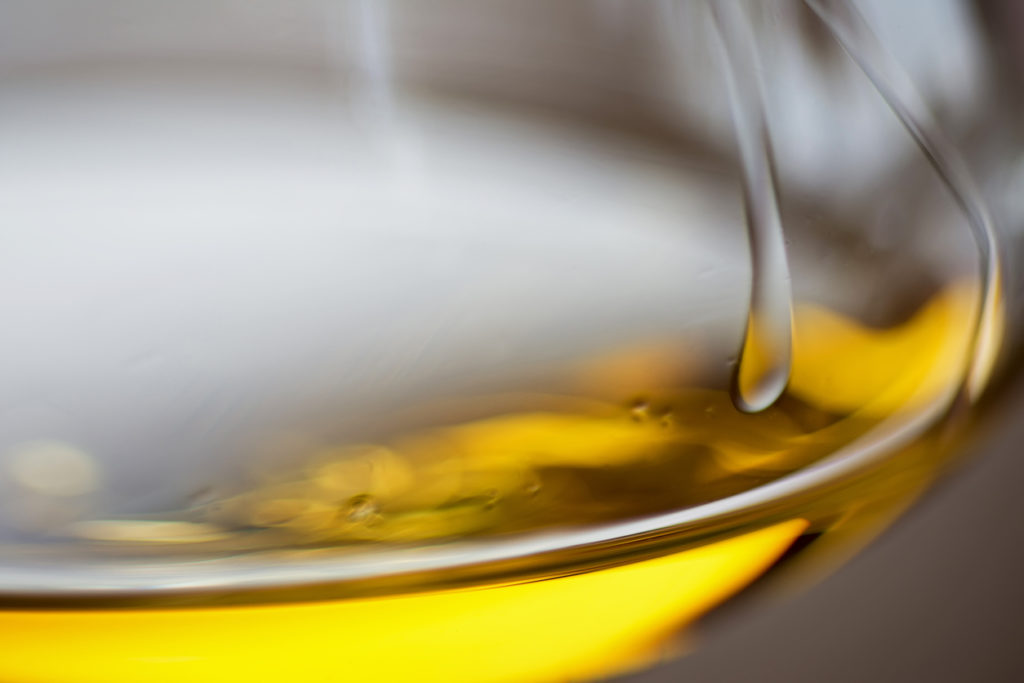
In conclusion, Auslese wines demonstrate the importance of precise grape selection and the influence that varying levels of ripeness and noble rot can have on a wine’s flavor profile. While not as intense as Beerenauslese, Auslese wines offer a diverse range of flavors, making them an essential part of Germany’s wine offerings.
Beerenauslese
Beerenauslese, also known as BA, is a high-quality German wine classification distinguished by its rare, luscious, and complex flavor profile. It is made from grapes affected by noble rot, which is the result of a fungus called Botrytis cinerea.
The presence of Botrytis cinerea in the vineyards enables the grapes to dehydrate and concentrate their flavors and sugar content. This results in highly sweet wines that can age well and develop unique and luxurious taste characteristics. However, the production of Beerenauslese wines is not always consistent, as the botrytis infection depends on specific weather conditions.
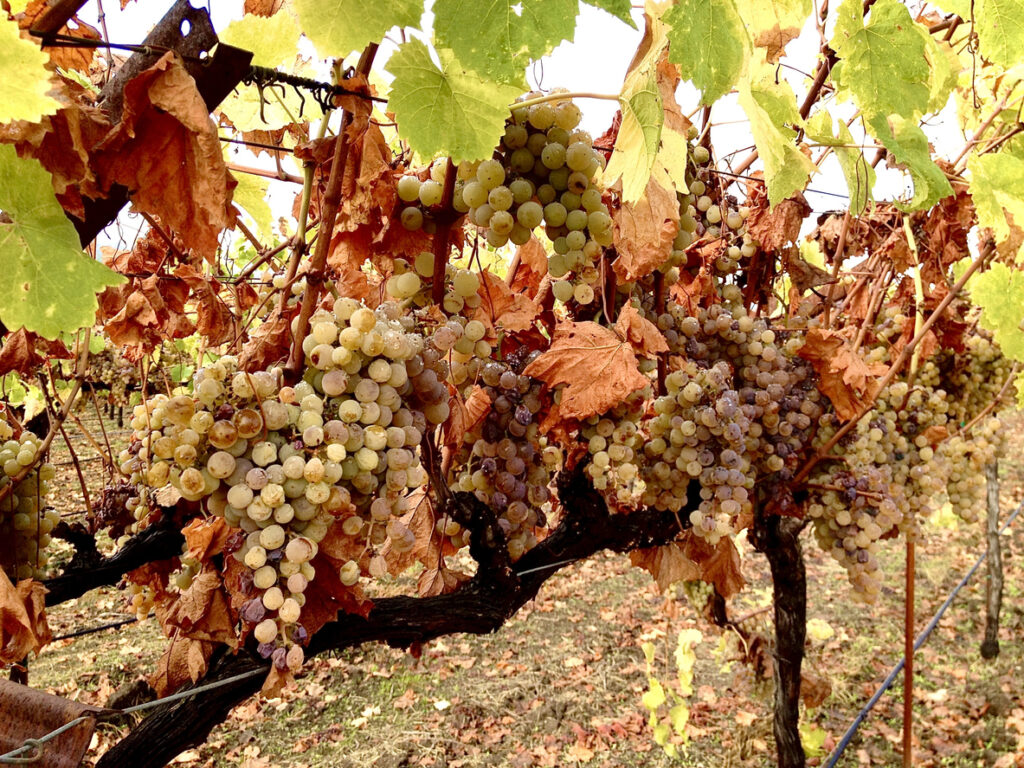
BA wines are typically made from Riesling, Gewürztraminer, or other grape varieties that are prone to late harvesting. The grapes are hand-selected during the harvest, ensuring that only the ripest and most botrytis-infected berries are used.
Sugar Content in Beerenauslese Wines
When it comes to taste, Beerenauslese wines are characterized by their rich, concentrated flavors and high levels of residual sugar, which can range from 110 to 140 grams per liter. The harmonious balance between sweetness and acidity is critical to the wine’s quality, allowing it to pair well with a variety of dishes, including cheeses, desserts, or even as a standalone drink.

Taste and Flavor of Beerenauslese Wines
Despite their intensity, BA wines possess a remarkable freshness and finesse, thanks to the vibrant acidity that counterbalances the sweetness. Besides the taste, the wine’s aroma showcases an array of fruit and floral notes, alongside honey and caramel nuances.
In conclusion, Beerenauslese stands as a unique treasure in the wine world due to its distinctive production process involving Botrytis cinerea and its unparalleled taste and aromas. As a result, it remains highly sought-after by wine enthusiasts and collectors, offering a singular experience for the palate and the senses.
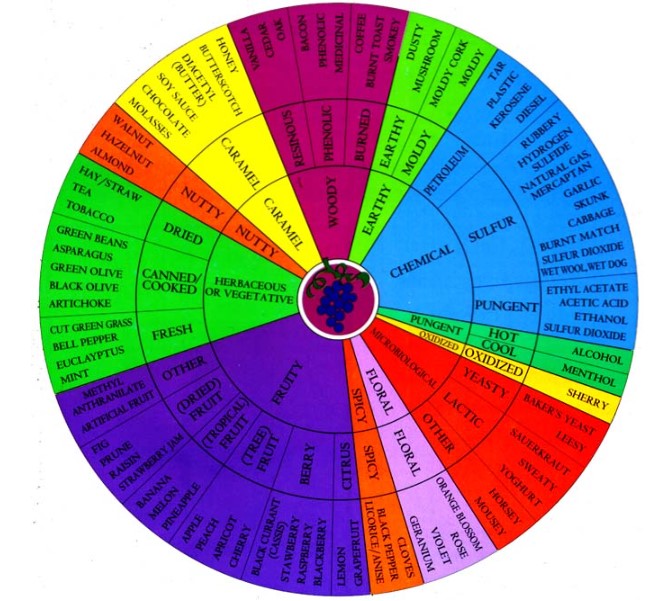
Trockenbeerenauslese
Trockenbeerenauslese, often abbreviated as TBA, is a German wine term that refers to a style of dessert wine made from grapes affected by noble rot. Noble rot, or Botrytis cinerea, is a type of mold that affects the grapes, causing them to shrivel and concentrate their sugars. This overall process results in Trockenbeerenauslese wines being sweet with high levels of residual sugar.

Trockenbeerenauslese wines are made using the highest quality grapes, and they are harvested selectively to ensure the right level of noble rot is present. These wines are typically produced in low quantities and are highly sought after. Some of the most respected wine regions in Germany, such as the Mosel, Rheingau, and Pfalz, are known for their exceptional Trockenbeerenauslese wines.
Taste and Flavor of Trockenbeerenauslese Wines
When it comes to flavors, Trockenbeerenauslese wines showcase an array of fruit tastes, including apricot, peach, and pineapple, along with honey and caramel notes. Despite their sweetness, these wines are also known for their balanced acidity which helps them age gracefully. In fact, Trockenbeerenauslese wines are known to have an aging potential of several decades, evolving in complexity over time.
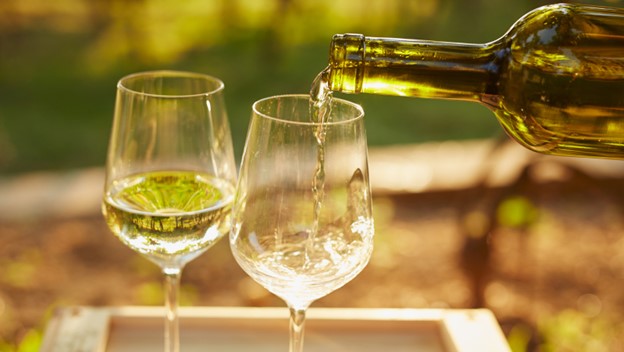
Foodpairing of Trockenbeerenauslese
Pairing Trockenbeerenauslese wines with food can be an enjoyable experience. These dessert wines pair well with rich, creamy cheeses like blue cheese or triple cream brie. Additionally, due to their sweetness and acidity, they can be a perfect match for fruit-based desserts and tarts.
In conclusion, Trockenbeerenauslese is a remarkable category within the German wine industry, defined by its sweetness, balanced acidity, and the presence of noble rot. The rarity and exceptional quality of these wines make them a treasure for wine enthusiasts and collectors alike.
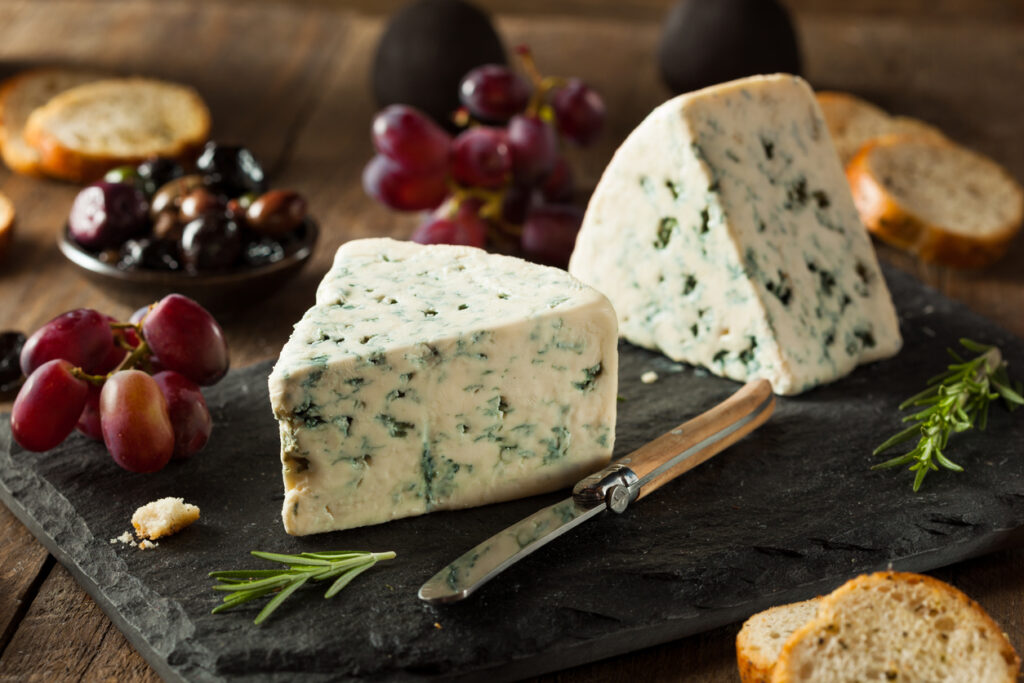
Eiswein or Ice Wine
It is a unique and highly-valued dessert wine known for its exceptional sweetness and concentrated flavors. Eiswein or ice wine is produced from grapes that have been left on the vine until they freeze naturally. The frozen grapes are then picked and pressed while still frozen, ensuring that only the most concentrated juice is extracted, as the water content remains frozen in the form of ice crystals.

The process of making Eiswein is meticulous and dependent on ideal weather conditions. A sudden frost or a fluctuating temperature can spoil the grapes, making this wine a risky yet rewarding venture for winemakers. The grapes are typically harvested during the night or early morning to maintain the required frozen state.
Characteristics of Eiswein
One noteworthy characteristic of Eiswein is that it can be made from various grape varieties. In German wine regions, Riesling is the most popular grape employed for its production, while Vidal is commonly used in Canadian ice wines. The resulting wines exhibit distinctive flavor profiles, ranging from intense fruitiness to vibrant acidity and minerality.
Sweetness of Icewine or Eiswein
Undoubtedly, Eiswein’s distinguishing feature lies in its sweetness – a direct result of the high sugar content extracted from the frozen grapes. However, it retains an elegant balance as the sweetness is complemented by racy acidity, which prevents the wine from becoming cloyingly sweet. This combination makes Eiswein a sought-after accompaniment for an array of desserts and richly flavored foods.
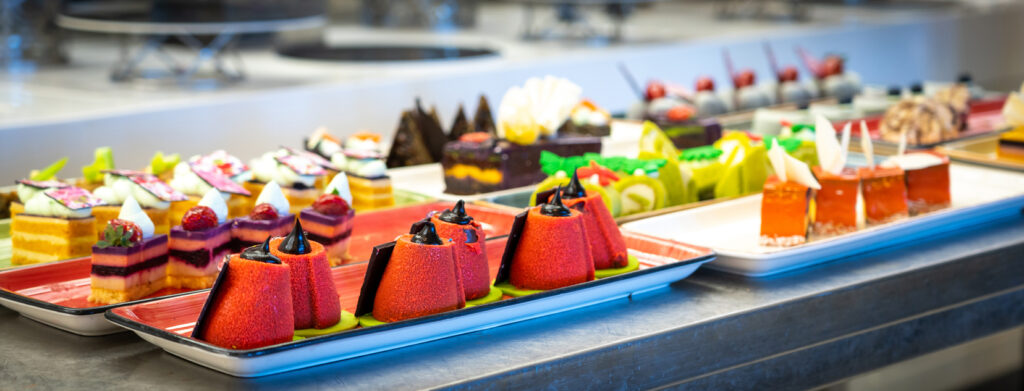
In regards to classification, Eiswein belongs to the Prädikatswein category – the highest quality level of German wines. It stands alongside other highly-regarded classifications such as Kabinett, Spätlese, Auslese, and Beerenauslese. Each classification signifies different styles and levels of sweetness, but all share the common trait of being made from carefully tended and selected grapes.
Anbaugebiete and Regions
The various categories of German wines, including Tafelwein, Qualitätswein, Kabinett, Spätlese, Auslese, and Beerenausleese, are produced across numerous distinct wine-growing regions, known as Anbaugebiete. These regions play a crucial role in shaping the characteristics and quality of the wines.
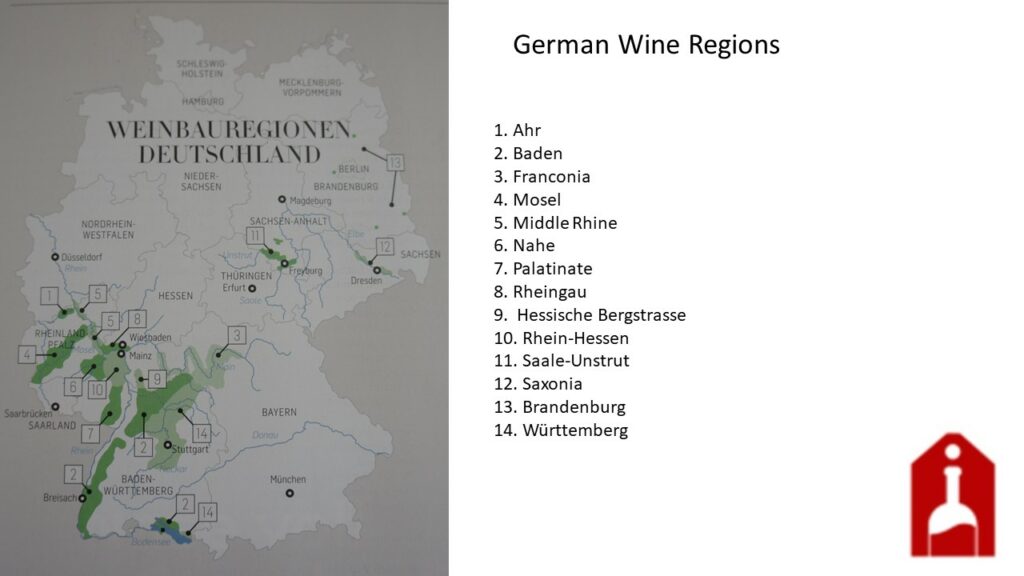
In Germany, there are 13 recognized Anbaugebiete, each boasting its unique terroir and climatic conditions. Some of the most well-known regions include:
Mosel
Situated along the Mosel River, this region is renowned for producing high-quality Rieslings with crisp acidity and distinct minerality. The steep vineyard slopes and slate soils create a unique microclimate. This allows the grapes to fully ripen, while the rivers reflect sunlight to provide consistent warmth.
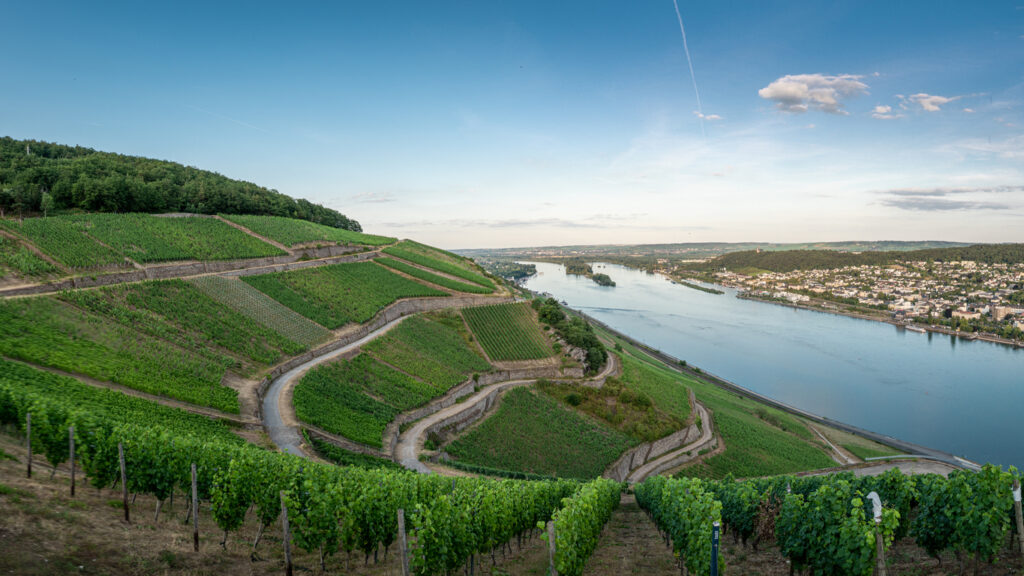
Rheingau
Located on the north bank of the Rhine River, this region is also recognized for its high-quality Rieslings, though with a fuller body and more pronounced fruitiness compared to Mosel. The south-facing slopes catch ample sunlight, ensuring a more reliable ripening process.
Pfalz
Being one of the sunniest and warmest German wine-growing regions, Pfalz cultivates a diverse array of grape varieties. Rieslings from this area are often rich and fruity, while the region’s red wine production is on the rise, particularly with Spätburgunder (Pinot Noir) grapes.

Baden
The southernmost wine region in Germany has a favorable climate for red wine production, with Spätburgunder being the dominant grape variety. Baden’s unique subregions and soil diversity also allow for the production of Müller-Thurgau, Grauburgunder, and Weissburgunder.
The quality of wines from these Anbaugebiete varies based on numerous factors such as vineyard location, soil composition, and vintage conditions. However, the strict labeling rules based on the wine classifications ensure that consumers can distinguish between the different quality levels. For instance, Qualitätswein is required to originate from a single Anbaugebiet, whereas Tafelwein may be sourced from various areas within Germany or the EU.

It is essential to recognize the role of Anbaugebiete and their respective regions in shaping the unique flavors and qualities attributed to German wines. By understanding these regions and the classification system, wine enthusiasts can better appreciate the diverse offerings of Germany’s thriving wine industry.
Grape Varieties and Styles
Tafelwein, Qualitätswein, Kabinett, Spätlese, Auslese, and Beerenausleese are categories of German wines with distinct characteristics. They represent a range of styles, sweetness levels, and grape varieties – or “Rebsorten” in German.
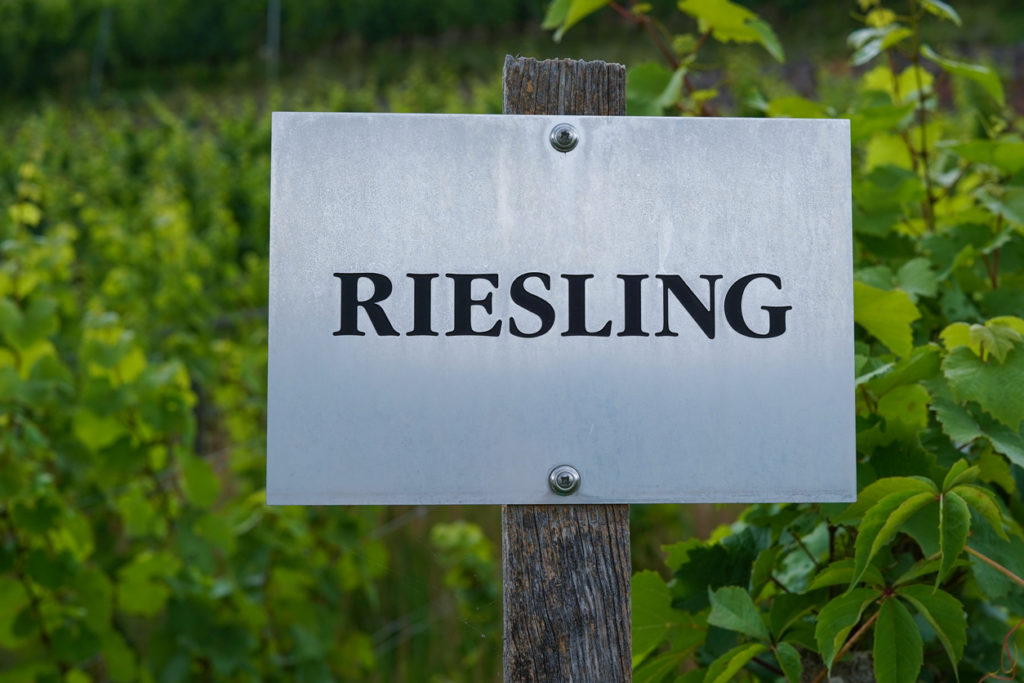
Grape Varieties The grape varieties play a significant role in defining the style and quality level of these wines. Both white and red grape varieties are used in their production. Some popular white grape varieties include:
- Riesling
- Müller-Thurgau
- Silvaner
- Gewürztraminer
Red grape varieties used in German wines include:
- Spätburgunder (Pinot Noir)
- Dornfelder
- Portugieser
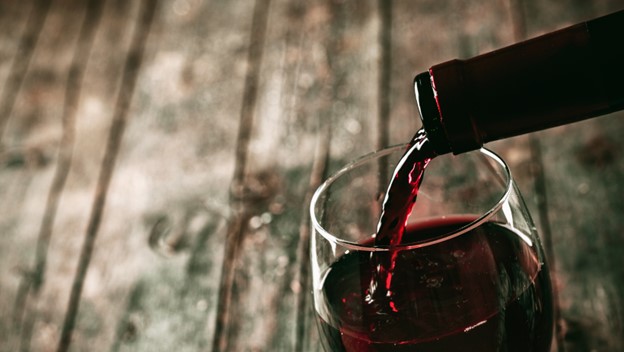
Styles Defined by Wine Categories
Tafelwein
This is a simple table wine that can be made from any combination of grape varieties. It has the lowest quality level and does not have to meet the strict standards of the other categories.
Qualitätswein
These are quality wines made from specific grape varieties, and they must undergo a rigorous taste and chemical analysis. Qualitätswein is further divided into two categories: Qualitätswein bestimmter Anbaugebiete (QbA) and Qualitätswein mit Prädikat (QmP).
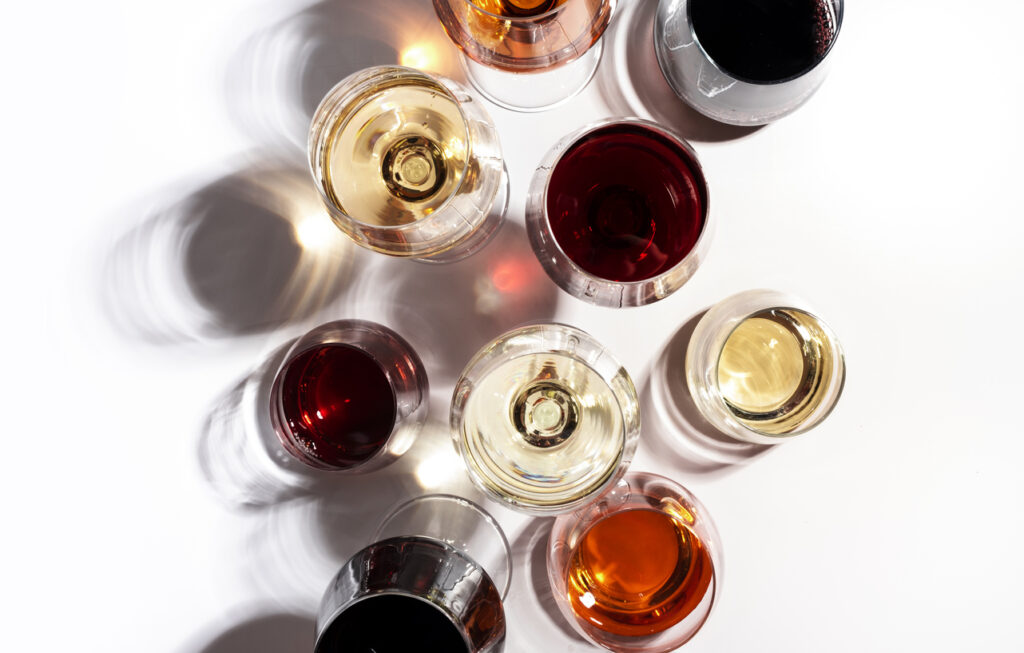
Kabinett
Kabinett wines are the first level of QmP wines, made from ripe grapes harvested during the main harvest season. They are typically light, fruity, and lower in alcohol content.
Spätlese
Spätlese wines are made from grapes harvested after the main harvest season, allowing them to develop more sugar and complexity. These wines have a higher sweetness level but retain a balanced acidity, making them versatile for both sipping and pairing with food.
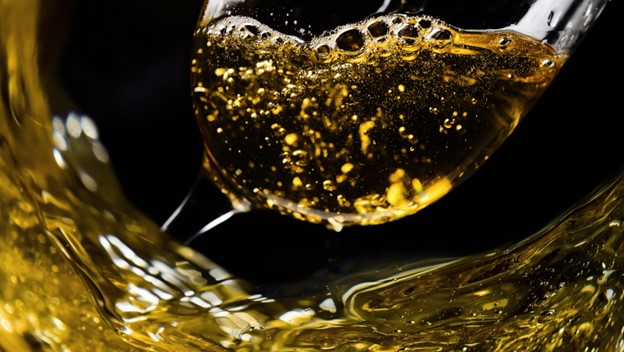
Auslese
Auslese wines are made from individually selected, extra-ripe grapes and can be rich, sweet, and more intense in flavor. They are considered to be dessert wines but can also pair well with rich, spicy foods.
Beerenauslese
These are dessert wines made from individually picked, overripe grapes affected by noble rot, a beneficial fungus that concentrates sugars and acids. Beerenauslese wines are very sweet and possess a unique, rich flavor.

The variety of grape, ripeness, and sweetness levels define each category’s style and quality, making German wines diverse and unique in their expression. Knowing the specific grape variety and wine category can help wine lovers identify the style and flavor they prefer, as each has characteristics distinct to their level of quality and the grapes used in their production.
Wine Labels and Terminology
Wine labels, or “etikett” in German, play a crucial role in conveying essential information about the wine to the consumer. German wine labels are regulated by the Deutsches Weininstitut to ensure clarity and accuracy.
Tafelwein
This is the most basic category of German wine. It is an uncomplicated, everyday table wine usually made from a mix of grape varieties. Tafelwein has minimal requirements regarding its origin and grape ripeness. As a result, it is an affordable option for wine drinkers.

Qualitätswein
They are a step above Tafelwein, encompassing wines made from specific grape varieties grown in one of Germany’s 13 designated wine regions. These wines must meet specific criteria in terms of grape ripeness, sugar content, and alcohol level. Qualitätswein is divided into two subcategories: Q.b.A (Qualitätswein bestimmter Anbaugebiete) and Q.m.P (Qualitätswein mit Prädikat).
The Q.m.P category includes several classifications, which indicate the level of grape ripeness at harvest. These are Kabinett, Spätlese, Auslese, Beerenauslese, and Trockenbeerenauslese.
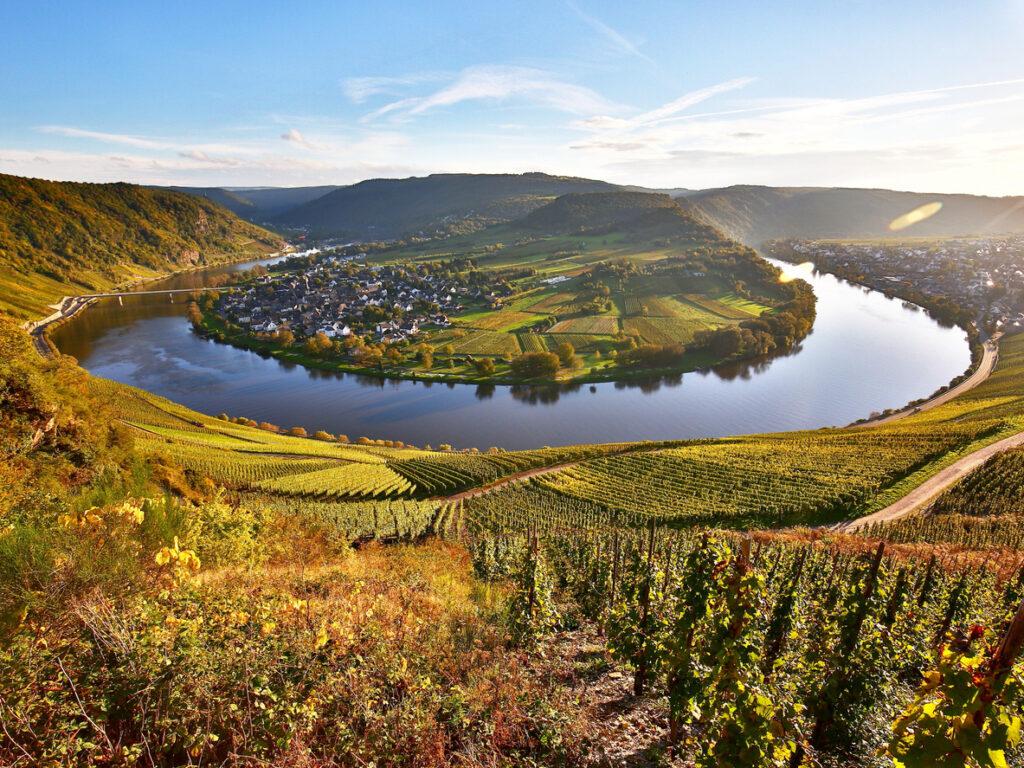
Kabinett
Kabinett wines are made from grapes that are fully ripe. They are light-bodied and have a low to moderate alcohol content, making them ideal for daily consumption.
Spätlese
It translates to “late harvest,” refers to wines made from grapes that are harvested later than those for Kabinett wines. This additional time on the vine often results in a higher sugar content and more concentrated flavors.
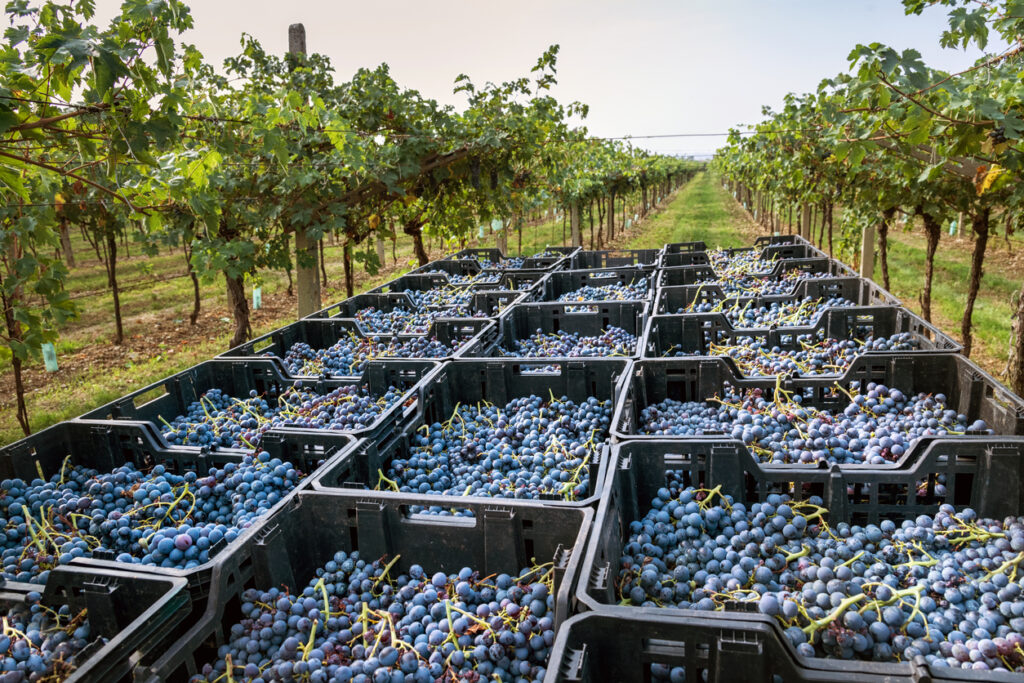
Auslese
These wines are produced from even more selectively harvested grapes, often gathered in multiple passes through the vineyard. These wines are richer and more flavorful than Spätlese wines, and can range from dry to sweet.
Beerenauslese and Trockenbeerenauslese
Both are dessert wines made from individually selected, overripe grapes affected by noble rot. The grapes have a high sugar concentration due to dehydration and botrytis, resulting in sweet, intensely flavored wines.
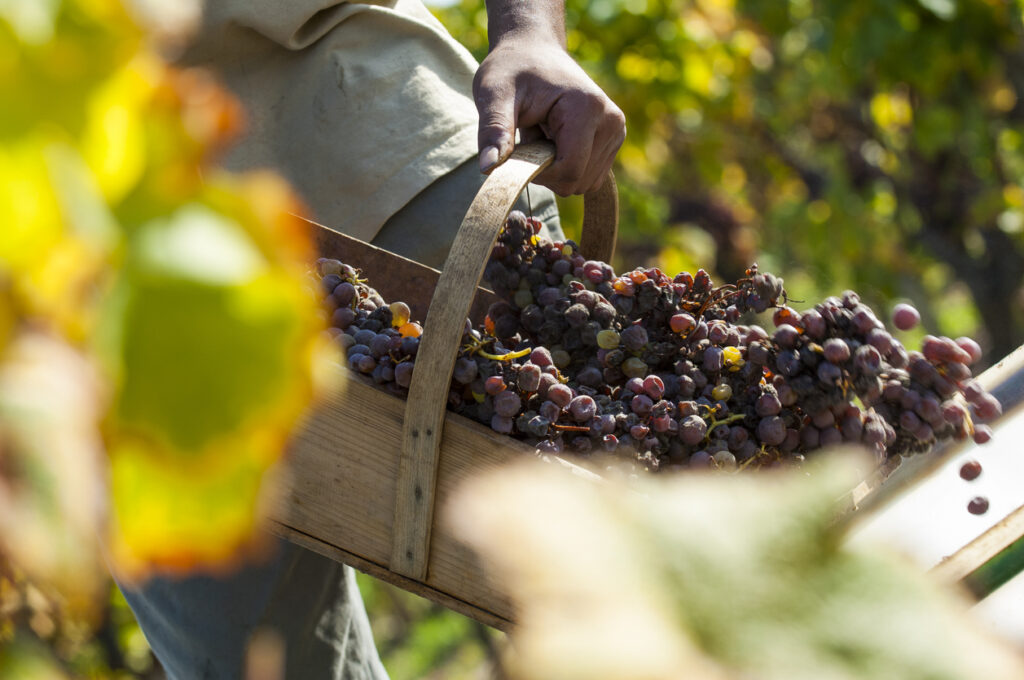
Understanding the terms and classifications on German wine labels can help consumers make informed decisions about the wine they are purchasing. With knowledge of the distinctions between Tafelwein, Qualitätswein, Kabinett, Spätlese, Auslese, and Beerenauslese, wine lovers can explore the diverse range of flavors and styles available in the world of German wine.
Quality Levels and Sweetness
Tafelwein, Qualitätswein, Kabinett, Spätlese, Auslese, and Beerenausleese are classifications of German wines that take into account both quality levels and sweetness. These categories help consumers understand the taste and characteristics of different wines, making it easier to select the perfect bottle for any occasion.
Tafelwein is the most basic level of German wine, known for its simple, everyday drinking quality. This wine may be less complex and have a lower status in the hierarchy of German wines.
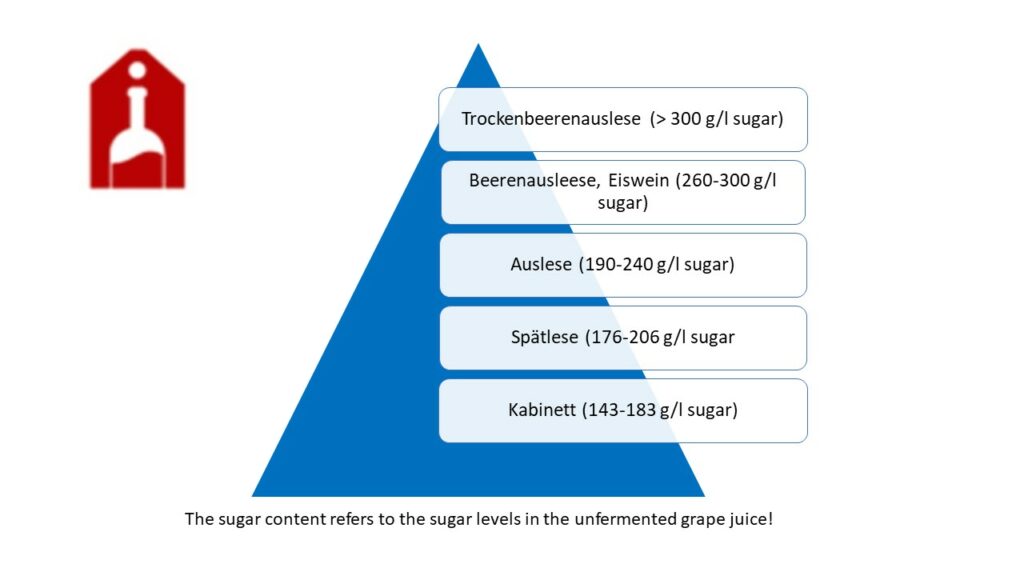
Moving up in quality, Qualitätswein represents a higher standard as it must meet specific regional and technical criteria. These wines undergo a thorough examination and tasting, ensuring their quality and establishing their character.
Within Qualitätswein, there are additional, more specific classifications, such as Kabinett, Spätlese, Auslese, and Beerenausleese. Each of these categories represents a different level of sweetness and ripeness at harvest.
Kabinett
wines are made from fully ripe grapes, offering a lighter, more delicate flavor than higher sugar-content wines. Kabinett wines tend to be low in alcohol and carry a higher acidity, which showcases their fruity flavors.
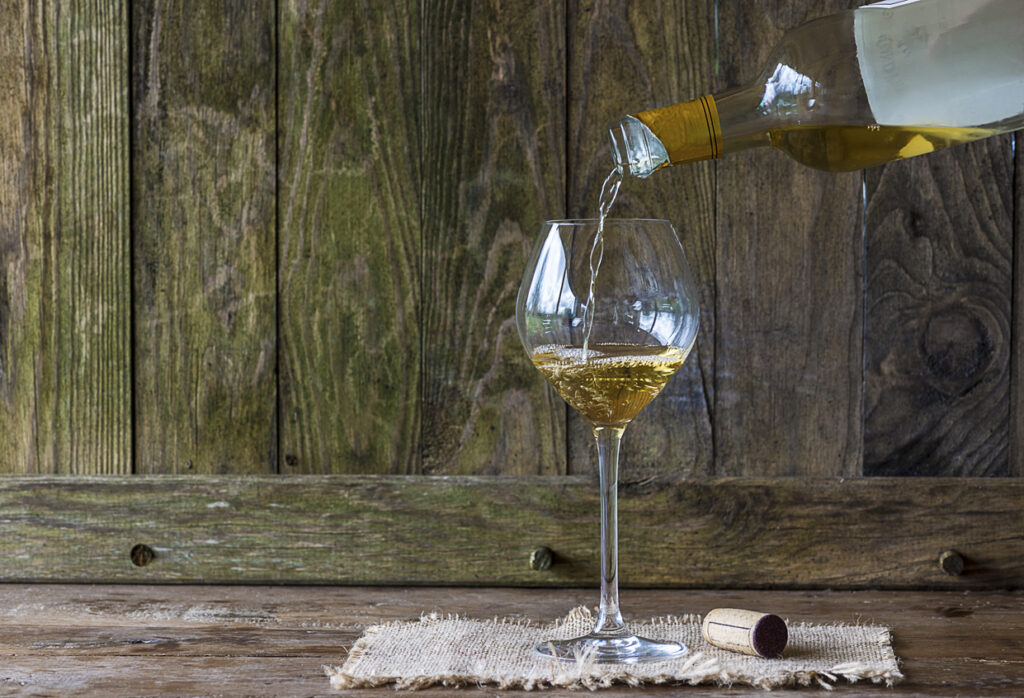
Spätlese
It translates to “late harvest,” and these wines are made from grapes harvested later than Kabinett, leading to higher sugar levels. This category showcases wines with more body, complexity, and, potentially, sweetness.
Auslese
These wines are produced from individually hand-picked, very ripe grapes, often affected by noble rot. These wines exhibit intense flavors, a rich mouthfeel, and pronounced sweetness.
Beerenausleese
They are created from individually selected, overripe grapes that have been affected by botrytis cinerea, or noble rot. As a result, these wines possess a luxurious sweetness balanced by acidity, making them perfect dessert wines.
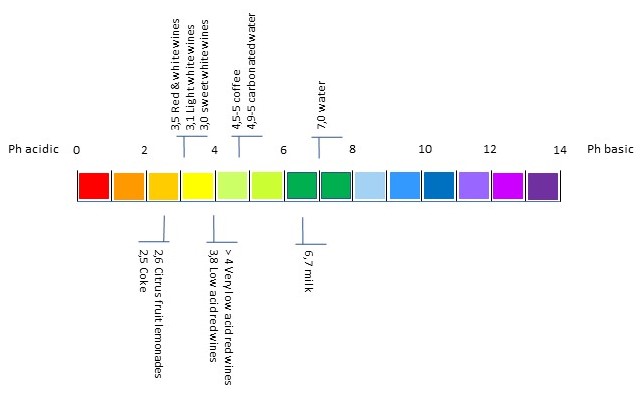
Sweetness in German wines, commonly referred to as süß (sweet) or restsüß (residual sweet), is directly related to the Zucker (sugar) content in the grapes at harvest. The residual sugar and pH levels determine the final sweetness of the wine. Some wines may be made in a drier style, while others may reach high levels of sweetness. These classifications, however, are not strict rules, and flavor profiles can vary among individual wines within the same category.
By understanding the quality levels and sweetness, wine enthusiasts can appreciate the diverse range of German wines. This way they make informed decisions when choosing the perfect bottle.
Vineyards and VDP Classification
In German wine-making, the classification of vineyards plays a crucial role in determining the quality and value of wines produced. At the heart of this classification system is the Verband Deutscher Prädikatsweingüter (VDP). This is an association that regulates the quality standards for German wineries and their vineyards.

VDP Classification vs. German Classification System
When it comes to wine classification systems, two prominent methods often come up for comparison: the VDP system and the German classification system. The VDP (Verband Deutscher Prädikatsweingüter) system is based on a regional approach, while the German system focuses on grape quality.
The VDP classification system is highly regarded for its emphasis on terroir and showcasing the uniqueness of each region. It categorizes wines into four levels: Gutswein (the basic level), Ortswein (village-level wine), Erste Lage (first growth vineyards), and Grosse Lage (grand cru sites). This classification aims to highlight the specific characteristics of each vineyard site, reflecting its soil composition, microclimate, and other unique factors.
On the other hand, the German classification system primarily revolves around grape quality.

The VDP Classification Categories
VDP Grosse Lage
This category represents the highest level of quality, with vineyards that produce exceptional wines with a distinctive character and style, influenced by the terroir. Grosses Gewächs wines come from these vineyards and are considered the finest dry German wines.
VDP Erste Lage
These vineyards are recognized for their high-quality terroir and potential to yield top-quality wines. Wines from erste lage vineyards often showcase a distinctive character, reflecting both their region and grape variety.
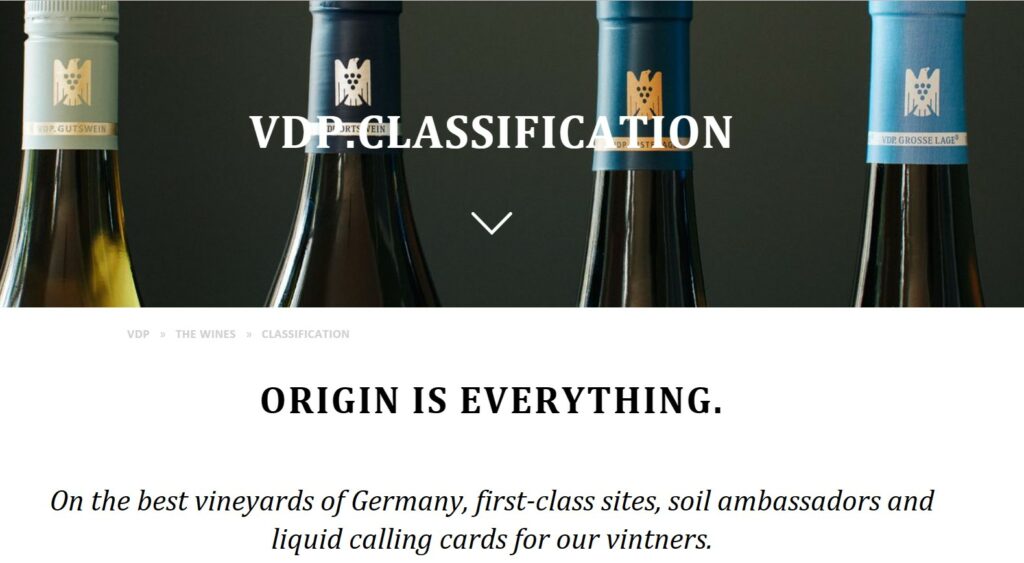
VDP Ortswein
Wines in this category come from quality-oriented vineyards within a specific village appellation. They must adhere to the VDP’s strict quality guidelines, including traditional grape varieties and lower yields.
VDP Gutswein
This level represents the entry point of the VDP classification. These wines come from a winery’s estate, reflecting the unique characteristics of the region they are produced in and adhering to strict quality standards.

